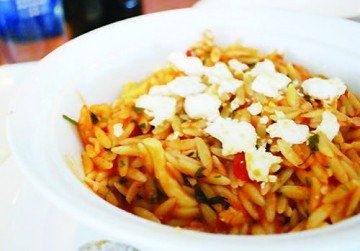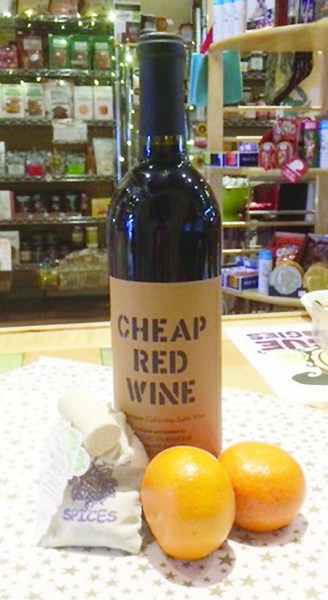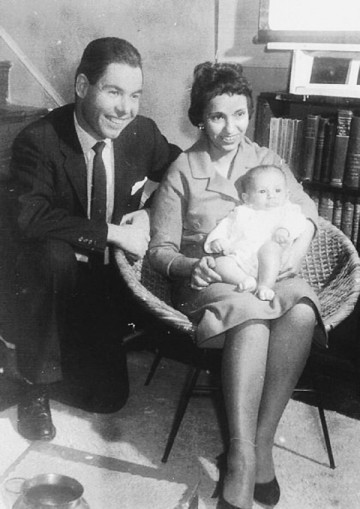By Krista Pfunder Boughey
In the great American melting pot, many families have a specialty that makes the holidays taste like home. Many of these recipes were passed down by family members who immigrated to the U.S.
Bay Weekly reached out to our friends and neighbors to see what food and drink from around the world are featured on their tables. We’re happy to share their treasured recipes with you.
Main Courses
Pernil
Puerto Rican recipe courtesy of Monica Alvarado of Bread and Butter Kitchen in Eastport
Pernil is a large part of the Puerto Rican Christmas dinner. It’s unctuous, savory, tender and delicious. As Alvarado’s husband’s family is from Puerto Rico, Pernil often finds its way to her table during celebrations and holidays. She adapted this recipe from her mother-in-law, Maria.
1 5- to 8-pound pork shoulder, bone-in
2 tablespoons vinegar
1⁄4 cup olive oil
1 cup sour orange juice; substitute a combination of fresh-squeezed lime and orange juice
1 medium yellow onion, quartered
10 garlic cloves, crushed
1 bunch cilantro, chopped
1 red bell pepper, diced
2 tablespoons cumin
2 tablespoons dried oregano
2 tablespoons smoked paprika
5 to 8 teaspoons kosher salt; 1 per pound of pork
2 teaspoons black pepper
1 to 2 cups water
Place pork shoulder skin-side up in large roasting pan. Cut slits into the skin and fat. Combine juice, vinegar, olive oil, onion, garlic, cilantro, red bell pepper, cumin, oregano, paprika, salt and pepper in a blender or food processor and puree into a smooth paste. Rub paste on all sides of the pork, into any crevices and into the slits cut in the skin. Cover with plastic wrap, refrigerate and marinate 12 hours to 2 days.
Remove from refrigerator and let sit at room temperature 30 minutes. Preheat oven to 325 degrees. Wipe off excess marinade; add pork to pan with two inches of water. Cover roasting pan tightly with foil or pan cover; place on lowest oven rack to bake 4 to 8 hours or until very tender.
Note: You really can’t overcook as long as you keep the heat low, the roast covered and the liquid in the pan. At the restaurant, we usually cook it 7 to 8 hours to ensure the pork is falling off of the bone.
The crispy skin, or cuero, is important. For the crispiest skin, uncover for the final hour. When done, place under the broiler for 5 or so minutes, or until skin is crisp and crackling. Keep an eye on it so it doesn’t burn. Let rest at least 20 minutes before serving.
Tourtiere
French Canadian recipe courtesy of Bea and JC Poulin, formerly of Shady Side, now residing in St. Mary’s County.
This is Poulin’s favorite French Canadian pie, traditionally eaten at Christmas. She learned to make it from her mother-in-law, who served it with either maple syrup or ketchup. Poulin prefers maple syrup. The recipe below is for two pies, one to eat and one to freeze.
2 pounds ground meat (beef, pork and/or venison; Poulin uses one pound of beef or venison, and one pound of lean pork)
1 large sweet onion, finely chopped
2 small garlic cloves, minced
2 stalks of celery, finely chopped
1 teaspoon salt
1⁄2 teaspoon ground cloves
1 cup of instant mashed potatoes
1 quart of water
1⁄2 stick of butter
4 pie dough pastries; prepared pie pastry is fine
Combine all ingredients except instant potatoes and butter in large stockpot and cover with water. Bring to a boil and cook uncovered until water is almost evaporated, 30-45 minutes.
Use a metal slotted spoon to chop ground meat to keep from clumping.
Add potatoes slowly until remaining liquid is absorbed. Let cool slightly.
Meanwhile, pre-bake bottom crusts for two pies at 400 degrees 5 to 8 minutes. Puncture raw dough with fork.
Spoon meat mixture into pre-baked pie crust and smooth out to about an inch thickness. Place tabs of butter over meat mixture, and cover with remaining un-baked pie crust. Crimp it to the pre-baked crust.
Bake at 375 degrees until top crust is golden brown, about 30 minutes.
Cool slightly and serve with maple syrup or ketchup.
Youvetsi
Greek recipe courtesy of Agia Anna Ladies Philoptochos Society, SS Constantine and Helen Greek Orthodox Church in Annapolis
In Greek households, this dish is served at holiday meals. The recipes are passed down from generation to generation.
1⁄2 cup olive oil, divided
31⁄2 pounds beef or lamb,
cut into 2-inch chunks
Salt and pepper to taste
1 large onion, diced
4 cloves garlic, finely minced
1 large leek, cleaned, trimmed and cut in half
1 large carrot, peeled and cut into thirds
1⁄2 cup dry white wine
3 to 4 whole allspice berries
1 28-ounce can crushed tomatoes
1 teaspoon sugar
1 quart of water
1 pound orzo pasta
Grated kefalotyri cheese or Pecorino Romano
In heavy, oven-safe Dutch oven or deep pan, heat 1⁄4 cup olive oil. Season meat lightly with salt and pepper and cook over medium-high heat until nicely browned, 7 to 10 minutes. Set aside.
Add 1⁄4 cup olive oil to the pan and sauté onions until translucent, 5 minutes. Add garlic and cook 1 minute. Add leek, carrot and wine to the pot and scrape up any bits that may have stuck to the bottom.
Add allspice berries, crushed tomatoes, sugar and a quart of water to the pan. Boil and then lower the heat to medium-low. Simmer uncovered 5 to 10 minutes. Return the meat, with juices, to the pot. Cover and simmer over medium-low heat for about 1 hour or until the meat is very tender. Remove the leek and carrot from the sauce and transfer the meat and sauce to a covered ceramic baker or continue using the Dutch oven.
Stir in the uncooked orzo pasta and add about 1⁄2 cup more water if needed. Season to taste with salt and pepper. Cover and cook at 350 degrees 45 minutes to 1 hour, stirring contents occasionally to prevent sticking. Remove from oven, remove the allspice berries and top with grated cheese. Cover and allow the dish to rest 15 to 20 minutes before serving.
Breads
Coconut Buns
Barbadian recipe courtesy of the Banneker-Douglass Museum in Annapolis. From the Museum’s 1984 cookbook of recipes traditionally served during the holiday season.
1 cup sifted flour
6 teaspoons shortening
1⁄2 cup sugar
1 cup grated coconut
1 pinch of salt
2 teaspoons baking powder
2 eggs
2 to 3 teaspoons milk or water
Measure and sift flour and salt into mixing bowl. Add shortening. Using fingertips, rub together until they look like crumbs. Stir in baking powder, coconut and sugar.
Beat eggs thoroughly and use to bind mixture to a stiff dough. Add milk or water if needed. Knead lightly and divide into buns.
Bake at 350 degrees 15 to 20 minutes in greased pan.
Dresdner Stollen
German recipe courtesy of Mike Selinger, owner of Old Stein Inn in Edgewater
This fruit bread is traditionally served at Christmas. The recipe makes two 13-inch bread loaves.
1⁄2 cup seedless raisins
1⁄2 cup dried currants
1 cup mixed candied citrus peel
1⁄4 cup candied Angelica, cut into 1/4-inch dice
1⁄2 cup candied cherries, cut in half
1⁄2 cup rum
1⁄4 cup lukewarm water (110 degrees -115 degrees)
2 packages active dry yeast
3⁄4 cup plus a pinch of sugar
51⁄2 cups plus 2 tablespoons all-purpose flour
1 cup milk
1⁄2 teaspoon salt
1⁄2 teaspoon almond extract
1⁄2 teaspoon finely grated fresh lemon peel
2 eggs, at room temperature
3⁄4 cup unsalted butter, cut into 1/4-inch bits and
softened
8 tablespoons melted unsalted butter
1 cup blanched slivered almonds
1⁄4 cup confectioners sugar
Combine raisins, currants, candied citrus peel, Angelica and cherries in a bowl. Pour the rum over them, tossing the fruit to coat the pieces evenly. Soak for at least 1 hour.
Pour lukewarm water into a small bowl and sprinkle it with yeast and a pinch of sugar. Let the mixture stand 2 or 3 minutes, then stir to dissolve the yeast. Set the bowl in a warm, draft-free place, such as a turned-off oven, for about 5 minutes.
Meanwhile, drain the fruit, reserving the rum, and pat pieces dry with paper towels. Place the fruit in a bowl and sprinkle with 2 tablespoons flour. Turn with a spoon until the flour is completely absorbed. Set aside.
In a heavy 2-quart saucepan, combine the milk, 1⁄2 cup of the sugar and the salt. Heat to lukewarm, 110 to 115 degrees, stirring constantly until the sugar dissolves. Off the heat, stir in reserved rum, almond extract, fresh lemon peel and then the yeast mixture.
Place 5 cups of flour in large bowl. Using a fork, stir in the yeast mixture, a cup or so at a time. Beat eggs until frothy and stir into the dough. Beat in bits of softened butter. Gather dough into a ball and place on a board sprinkled with the remaining 1⁄2 cup of flour. Knead the dough for about 15 minutes, or until all the flour is incorporated and dough is smooth and elastic. Flour your hands lightly from time to time. Press fruit and almonds into the dough, 1⁄3 cup or so at a time, but do not knead or handle it too much or the dough will discolor. Coat a deep bowl with 1 teaspoon melted butter and drop in the dough.
Brush the top of the dough with another 2 teaspoons melted butter, drape a towel over the bowl and set it in a warm, draft-free place for 2 hours or until the dough doubles in bulk. Punch dough down and divide into two equal pieces. Let them rest 10 minutes, then roll pieces into strips about 12 inches long, 8 inches wide and 1⁄2 inch thick. Brush each strip with 2 tablespoons of the remaining sugar. Fold each strip lengthwise by bringing one long side over to the center of the strip and pressing the edge down lightly. Then fold the other long side across it, overlapping the seam down the center by about 1 inch. Press the edges gently. With lightly floured hands, taper ends of the loaf slightly and pat sides gently together to mound it in the center. Loaf should be about 31⁄2 to 4 inches wide and 13 inches long.
With a pastry brush, and 1 tablespoon of melted butter, coat bottom of an 11-by-17-inch jellyroll pan. Place loaves on pan and brush with remaining 2 tablespoons of melted butter. Set the loaves aside in a warm draft-free place for about 1 hour or until doubled in bulk. Bake at 375 degrees in the middle of the oven for 45 minutes or until golden-brown and crusty. Transfer the loaves to wire racks to cool completely. Just before serving, sprinkle with sifted confectioners sugar.
Dessert
Kourabiethes
Greek recipe courtesy of Agia Anna Ladies Philoptochos Society, SS Constantine and Helen Greek Orthodox Church in Annapolis
The ladies of the chapter gather together before holidays and events to prepare these cookies.
2 pounds sweet butter
1 cup 10x powdered sugar
2 ounces whiskey, ouzo or cognac
1 orange, juiced
2 teaspoons baking powder
10 cups flour
2 egg yolks
Cream butter. Add sugar; beat until light and fluffy. Add liquor and orange juice, continue to cream. Add egg yolks, and continue creaming.
Sift 2 cups of flour and baking powder together. Add to mixture. Continue to cream until mixture is light and fluffy, 20 to 25 minutes
Remove from mixing bowl and put in a very large bowl. Add 6 to 8 cups of flour. When dough is pliable, mold into small balls or other desired shapes.
Bake in 350-degree oven 25 to 30 minutes until golden.
Beverages
Coquito
Puerto Rican recipe courtesy of Monica Alvarado of Bread and Butter Kitchen in Annapolis
“Served only at the holidays, you know it’s Christmas time when you’re handed a glass of Coquito,” Monica Alvarado says. “No Puerto Rican parranda is complete without a pitcher.”
12 ounces evaporated milk
14 ounces condensed milk
15 ounces sweetened cream of coconut
14 ounces coconut milk
3 cups white rum
2 teaspoons vanilla extract
1 teaspoon ground cinnamon
2 cinnamon sticks
1 vanilla bean, split in half lengthwise (optional)
Combine evaporated milk, condensed milk, coconut cream and coconut milk in a large blender and blend until well combined. Be sure it’s smooth. Add rum, vanilla and ground cinnamon. Mix.
Pour into a pitcher or glass bottles with sealed lids and drop in cinnamon sticks and vanilla bean halves. Cover and chill in refrigerator for at least 2 hours or until very cold.
Serve straight in small glasses on the rocks. Add dash of cinnamon and a cinnamon stick. Leftovers will keep tightly sealed in the refrigerator for one week. Shake well before serving.
Mulled Wine
Recipe courtesy of Annebeth Bunker, owner of Annebeth’s in Annapolis
Mulled wine is a traditional holiday beverage served in Scandinavia, Sweden, Finland and many other countries.
1 bottle of full-bodied red wine (does not have to be expensive)
Whole orange studded with 10 cloves
2 cinnamon sticks
5 star anise
1 teaspoon allspice
12 ounces. cranberry juice
1⁄4 cup spiced rum
Zest orange and then stud with cloves. Add all ingredients together and warm slowly together in pan, but do not let boil.
Rompope
Ecuadorian recipe courtesy of Anthony Nolan of Lothian
Rompope originated in Mexico but has become a popular holiday drink throughout much of Latin America. Anthony Nolan remembers his mother, who was born in Ecuador, serving it at her annual Christmas party.
1⁄2 cup almonds
6 cups milk
1 cup sugar
4 egg yokes
Rum (to taste)
Soak almonds in boiling water and peel them. Using blender, blend almonds with a little milk until smooth. Bring remainder of milk to a simmer, add sugar and blended almonds.
Stirring constantly, continue to heat until sugar is completely dissolved and the liquid is thickened. Remove from heat. Beat egg yolks with rum. Slowly pour egg mixture into milk mixture whisking until thoroughly blended. Let cool completely. Serve over crushed ice.





